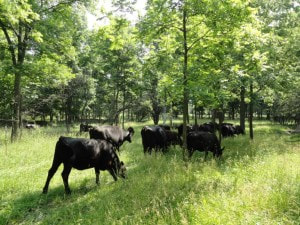Northeast / MidAtlantic Agroforestry
An informal introduction to what we do:
Northeast/Mid-atlantic agroforestry (NEMA Agroforestry) aims at spreading the wonders different agroforestry practices. We believe that greater implementing of such practices will bring us one step closer to a sustainable future, benefiting the land owner, environment, and the surrounding community.
Northeast/Mid-atlantic agroforestry (NEMA Agroforestry) aims at spreading the wonders different agroforestry practices. We believe that greater implementing of such practices will bring us one step closer to a sustainable future, benefiting the land owner, environment, and the surrounding community.
Why is Agroforestry Relevant to the Northeast and the Mid-Atlantic?
Our regional forests are important for timber and wood products, recreation, wildlife, and aesthetics, but also provide important ecological services such as clean air and water. About 70 percent of the 17 million acres of forestland in Pennsylvania is privately owned. An estimated 20 percent of those private forestlands are associated with farms, but the management of these forests is rarely integrated into farming operations. Statistics from the 2007 Census of Agriculture indicate that while the number of farms in Pennsylvania is holding steady, the size of the average Pennsylvania farm decreased by nine acres between 2004 and 2007. Today the average Pennsylvania farm is 123 acres in size, but 38 percent of Pennsylvania farms are less than 50 acres. New farmers are facing farmland prices ranging from $3,000 to $7,000 per acre. With the size of farms shrinking and the cost of farmland rising, farmers are increasingly looking to glean more productivity from their land holdings, including their forestland. Well-managed agroforestry systems can provide farmers and other forest land Agroforestry practices can provide these landowners with additional tools to manage their forested in a sustainable manner while still realizing economic benefits.
Our regional forests are important for timber and wood products, recreation, wildlife, and aesthetics, but also provide important ecological services such as clean air and water. About 70 percent of the 17 million acres of forestland in Pennsylvania is privately owned. An estimated 20 percent of those private forestlands are associated with farms, but the management of these forests is rarely integrated into farming operations. Statistics from the 2007 Census of Agriculture indicate that while the number of farms in Pennsylvania is holding steady, the size of the average Pennsylvania farm decreased by nine acres between 2004 and 2007. Today the average Pennsylvania farm is 123 acres in size, but 38 percent of Pennsylvania farms are less than 50 acres. New farmers are facing farmland prices ranging from $3,000 to $7,000 per acre. With the size of farms shrinking and the cost of farmland rising, farmers are increasingly looking to glean more productivity from their land holdings, including their forestland. Well-managed agroforestry systems can provide farmers and other forest land Agroforestry practices can provide these landowners with additional tools to manage their forested in a sustainable manner while still realizing economic benefits.
NEMA Agroforestry Practices
Agroforestry: agricultural practices that incorporate trees and shrubs for cultivation and conservation
Alley Cropping
|
Alley cropping is an agroforestry practice that incorporates rows of trees with a companion crop grown in between the rows of trees. Alley cropping can diversify farm income, increase crop production, improve landscape aesthetics, enhance wildlife habitat, and provide protection and conservation benefits to crops.
Additional fact sheets on Alley Cropping: National Agroforestry Center – Alley Cropping Association For Temperate Agroforestry – Alley Cropping Univ. Missouri Center for Agroforestry – Alley Cropping |
Silvopasture
|
The agroforestry practice of silvopasture brings together trees with forage and livestock production. A silvopastural system can produce a long term income opportunity from the timber of the trees and provide a short term income opportunity from the livestock.
Additional fact sheets on Silvopasture: USDA National Agroforestry Center – Silvopasture USDA National Agroforestry Center – Silvopasture Handbook Association for Temperate Agroforestry – Silvopasture |
Windbreaks (Hedgerows/Snow Breaks)
|
Windbreaks are an agroforestry practice that use trees and shrubs to enhance crop production, protect people and livestock, and to benefit soil and water conservation. Hedgerows are similar to windbreaks in that they are comprised of trees and shrubs, some of their functions include increased biodiversity, reduced erosion, reduced runoff, and regulation of water flow between different areas.
Additional fact sheets on Windbreaks: USDA National Agroforestry Center – Windbreaks Univ. of Missouri Center for Agroforestry – Windbreaks Univ. of British Columbia – Hedgerows |
Forest Farming
|
The agroforestry practice of forest farming utilizes the forest canopy to provide protection and the correct shade level to grow high value specialty crops. The forest canopy is generally modified to provide the correct conditions to grow the specialty crops.
Additional fact sheets on Forest Farming: USDA National Agroforestry Center – Forest Farming Association for Temperate Agroforestry – Forest Farming Agroforestry Research Trust – Forest Farming |
Riparian Buffers
|
The use of Riparian Buffers is an agroforestry practice that incorporates trees, shrubs, and grasses to a streamside. The buffer will reduce non-point source pollution, reduce bank erosion, increase biodiversity, and provide habitat and protection for wildlife.
Additional fact sheets on Forest Farming: USDA National Agroforestry Center – Riparian Forest Buffers Chesapeake Bay Program – Riparian Forest Buffers Penn State Extension – Riparian Forest Buffers |








